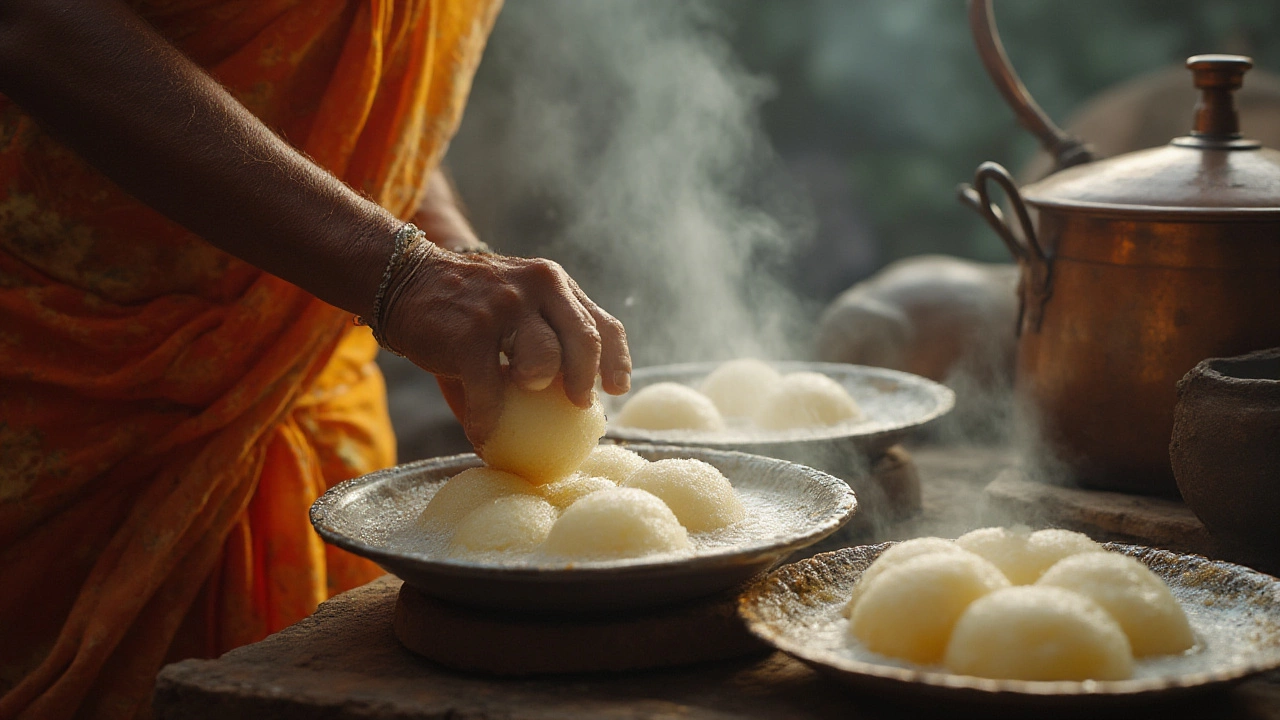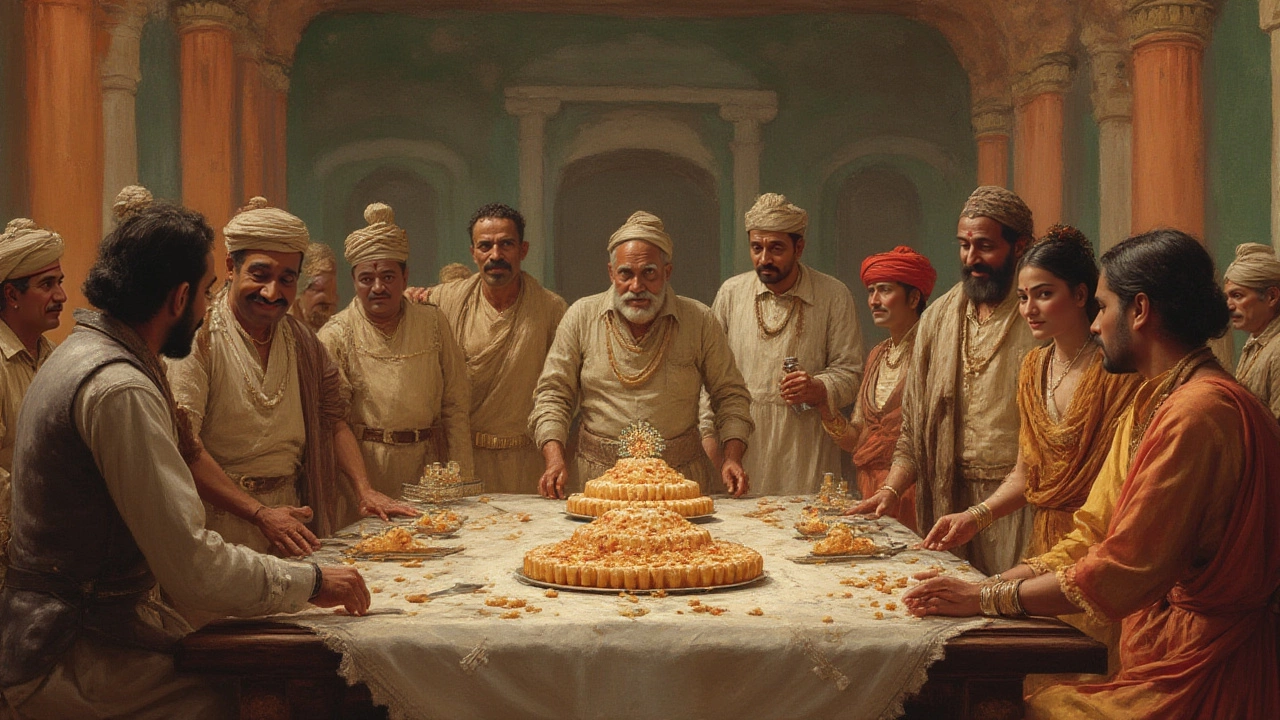Bengalis have this silent pride—the quiet belief that only their grandmothers hold the secret to the softest, spongiest rasgulla. But here’s the catch: the state of Odisha also claims it’s theirs, with legends going back centuries. The fight for India’s “official sweet” isn’t just about sugar and chhena (cottage cheese)—it’s a battle of heritage, love, and what it means to be Indian. Most people are stunned to learn that in 2017, the humble rasgulla was officially declared the country’s favorite sweet, after years of squabbling and heated debates at every family dinner table from Kolkata to Bhubaneshwar.
The Birth and History of the Rasgulla
Let’s travel back in time for a minute—no DeLorean required. The rasgulla’s roots go way deeper than most desserts ever could. According to Odisha’s centuries-old Jagannath Temple records, sweets similar to rasgulla, called "Khira Mohana," have been offered to Lord Jagannath since the 12th century. These weren't airy, snowy-white balls, but the forerunners of today’s syrupy candies. Fast forward to the 19th century, and along comes Kolkata-based confectioner Nobin Chandra Das, who tweaked the process, making rasgulla what the world loves now: chhena and semolina rolled into balls, boiled in pure sugar syrup till they float like baby clouds. Different stories clash, but both Bengal and Odisha have fiercely defended their versions in court.
So who won? In 2017, West Bengal received the coveted “Geographical Indication” (GI) tag for the “Banglar Rasogolla,” marking the variety made in Bengal as unique. Soon after, Odisha got its own GI tag for “Odisha Rasagola,” each with subtle differences in texture, taste, and color. Still, the rasgulla, regardless of pronounciation, has become India’s most widely recognized sweet treat. It’s found on railway platforms, festival trays, and even in Bollywood songs. For many, a meal just isn’t over until a rasgulla brings it to a sweet, buoyant finish.
What Makes a Rasgulla So Special?
If you’ve only ever glanced at rasgulla in a can at the grocery store, you’re missing out. A freshly made rasgulla is bouncy to the touch, sweet but not cloying, and oozes syrup with every bite. The magic lies in the simple stuff: just cow’s milk, maybe a hint of cardamom, and patience. The process starts with curdling milk with lemon juice or vinegar, straining it to get that fluffy chhena, then kneading it until silk-smooth. The balls are dropped into bubbling syrup, and the transformation is almost magical—plump, juicy, never rubbery.
Here’s where it gets interesting. Bengal rasgulla tends to be pure white and spongy (almost squeaky under your teeth). Odisha’s rasgulla, often cooked a bit longer, takes on a golden tinge and a richer, almost caramel-like taste. Ask any local, and they’ll proudly say their mother’s recipe is the right way, no questions asked.
- Official sweet of India since 2017
- West Bengal’s and Odisha’s unique recipes, each with their own Geographical Indication (GI) tag
- Mostly made from only three ingredients: cow’s milk, sugar, and acidic curdling agent
- Served cold or at room temperature, always soaking in light syrup
- Associated with religious offerings at Puri’s Jagannath Temple every July for Rath Yatra
It’s not just a dessert, either. Indian astronauts have even carried rasgulla into space—a 2019 experiment made rasgulla the first Indian sweet designed as a bite-sized, zero-gravity treat. There’s simply no stopping rasgulla’s journey.

Rasgulla By The Numbers: Fun Facts and Cultural Stats
Sweets are almost a second language across India, but rasgulla crosses regional, class, and even generational divides. Just check out these facts and data from recent years:
| Year | Event | Interesting Stat / Fact |
|---|---|---|
| 2017 | West Bengal GI tag | First state to get GI tag for “Banglar Rasogolla” |
| 2019 | Odisha GI tag | Odisha’s version officially recognized |
| 2022 | Annual Production (West Bengal) | Estimated 60,000+ tons made yearly |
| 2023 | Export | Rasgulla shipped to 25+ countries directly from India for festivals |
| 2019 | Space Mission | ISRO scientists create rasgulla for astronauts |
Getting rasgulla on your plate is a daily routine for millions, especially during the Durga Puja celebrations in West Bengal—factories might crank out a million pieces a day just to keep up with demand. And there’s a sweet twist: Odisha’s annual Rasgulla Dibasa (Rasgulla Day) falls in July, right after the rituals at Jagannath Temple, to honor the original sweet’s religious roots.
Tips for Tasting and Making the Perfect Rasgulla
So, maybe you’re hunting for the real thing in your city? Start with the obvious: look for shops claiming fresh batches each day; canned rasgulla is fine in a pinch, but it lacks that soft, yielding character. The syrup should be clear, not sticky or brown, and the balls must spring back when pressed lightly.
The adventure really takes off if you try making your own at home. Here are a few tips faded down from generations of sweet-makers:
- Use pure cow’s milk for the best flavor—buffalo milk can make it dense.
- Knead the chhena till it’s silky. Don’t stop too early or your rasgulla will crack while boiling.
- Drop the balls into boiling syrup gently; don’t crowd the pan, or it’ll mess with their shape.
- Cover and simmer for at least 15-20 minutes to keep them fluffy as they soak up syrup.
- Serve after chilling a few hours, or enjoy warm—everyone has a preference!
For that authentic Bengali flavor, toss a pod of cardamom in the syrup or even a dash of rose water. Odisha’s devotees sometimes add a spoonful of jaggery for a bolder note. The difference is small, but handled right, it changes the whole experience.

Why Rasgulla Remains India’s Sweetheart
It’s easy to take rasgulla for granted—walk into any corner shop, and it’s there, soft and glistening among the sweets. What makes it truly India’s sweetheart isn’t just the taste. It’s how the rasgulla shows up wherever life gets a little bit brighter: weddings, birthdays, new jobs, even exam results. Families exchange big tins during the festive season; train travelers buy it at every station stop from Howrah to Bhubaneswar. It’s a symbol that says, "You’re welcome here."
The fight for the ‘official sweet’ status only fueled its legend. Kids in both Bengal and Odisha grow up listening to bedtime stories about who invented it first, and for all the rivalry, the rasgulla brings people together with every bite. Maybe that’s the secret—you can debate, argue, even fight about rasgulla. But when the sweets are passed around, nobody says no. Sometimes food doesn’t just fill you up, it tells you who you are. For millions in India and abroad, nothing says home quite like that first syrupy, squishy, pure white ball. Rasgulla isn’t just a sweet. It’s home, history, heritage, and more than a little piece of every Indian heart.
